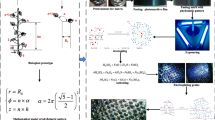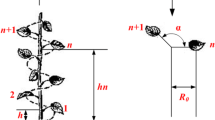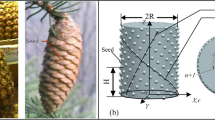Abstract
In order to reduce grinding temperature, a new kind of grinding wheel with an abrasive phyllotactic pattern based on the phyllotactic theory of biology has been presented. The model of the grinding temperature of the grinding wheel with an abrasive phyllotactic pattern was established in this paper. This model can also be suitable for other engineered grinding wheels. Another engineered grinding wheel and a common grinding wheel with random grains have also been designed and manufactured to compare with the grinding wheel with an abrasive phyllotactic pattern. The simulations and experiments of grinding temperature with three kinds of grinding wheel using the established model have been conducted. The results not only prove the validity of the model but also show that the grinding wheel with an abrasive phyllotactic pattern can effectively reduce the grinding temperature than the others. Finally, the relationship between the phyllotactic coefficient and grinding temperature was also studied.
Similar content being viewed by others
References
Heinzel C, Meyer D, Kolkwitz B, Eckebrecht J (2015) Advanced approach for a demand-oriented fluid supply in grinding. CIRP Annals-Manufacturing Technology 64(1):333–336
Mandal B, Singh R, Das S, Banerjee S (2011) Improving grinding performance by controlling air flow around a grinding wheel. Int J Mach Tools Manuf 51(9):670–676
Wang SB, Wu CF (2006) Selections of working conditions for creep feed grinding. Part (III): avoidance of the workpiece burning by using improved BP neural network. Int J Adv Manuf Technol 28(1–2):31–37
Vafaeesefat A (2009) Optimum creep feed grinding process conditions for Rene 80 supper alloy using neural network. Int J Precis Eng Manuf 10(3):5–11
Setti D, Sinha MK, Ghosh S, Rao PV (2015) Performance evaluation of Ti–6Al–4 V grinding using chip formation and coefficient of friction under the influence of nanofluids. Int J Mach Tools Manuf 88:237–248
Lee PH, Nam JS, Li C, Lee SW (2012) An experimental study on micro-grinding process with nanofluid minimum quantity lubrication (MQL). Int J Precis Eng Manuf 13(3):331–338
Mao C, Huang Y, Zhou X, Gan H, Zhang J, Zhou Z (2014) The tribological properties of nanofluid used in minimum quantity lubrication grinding. Int J Adv Manuf Technol 71(5–8):1221–1228
Wong KV, De Leon O (2010) Applications of nanofluids: current and future. Advances in Mechanical Engineering 2:519659
Nguyen T, Zhang LC (2010) Grinding–hardening using dry air and liquid nitrogen: prediction and verification of temperature fields and hardened layer thickness. Int J Mach Tools Manuf 50(10):901–910
L.C. Zhang, T. Nguyen, B. Oliver, A grinding wheel assembly and a method of grinding, Australia Patent No. 20044901614.
Nguyen T, Zhang LC (2005) Modelling of the mist formation in a segmented grinding wheel system. Int J Mach Tools Manuf 45(1):21–28
Shi, Chaofeng, Xun Li, and Zhitong Chen (2013) Design and experimental study of a micro-groove grinding wheel with spray cooling effect. Chinese Journal of Aeronautics 27(2):407–412
Li X (2014) Application of self-inhaling internal cooling wheel in vertical surface grinding. Chinese Journal of Mechanical Engineering 27(1):86–91
Aurich JC, Kirsch B, Herzenstiel P, Kugel P (2011) Hydraulic design of a grinding wheel with an internal cooling lubricant supply.Production. Engineering 5(2):119–126
KIRSCH, B., HERZENSTIEL, P., & AURICH, C. (2010). Experimental Result using a Grinding Wheel with an Internal Cooling Lubricant Supply. InProceedings 4th CIRP International Conference on High Performance Cutting(Vol. 1, pp. 2010–10).
Ma K (2011) Fundamental study on utilization of heat pipe technology to enhance heat transfer in the grinding contact zone [D]. Nanjing University of Aeronautics and Astronautics, Nanjing
He Q, Fu Y, Xu H, Ma K (2014) Investigation of a heat pipe cooling system in high-efficiency grinding. Int J Adv Manuf Technol 70(5–8):833–842
Tawakoli T, Westkämper E, Rabiey M (2007) Dry grinding by special conditioning. Int J Adv Manuf Technol 33(3):419–424
Tawakoli T, Daneshi A (2013) Green grinding with innovative wheel topography. Int J Precis Eng Manuf 14(7):1209–1212
Denkena B, Grove T, Göttsching T (2015) Grinding with patterned grinding wheels. CIRP J Manuf Sci Technol 8:12–21
Aurich JC, Herzenstiel P, Sudermann H, Magg T (2008) High-performance dry grinding using a grinding wheel with a defined grain pattern.CIRP. Annals-Manufacturing Technology 57(1):357–362
Reinhardt D, Pesce ER, Stieger P, Mandel T, Baltensperger K, Bennett M, Traass J, Friml J, Kuhlemeier C (2003). High-performance dry grinding using a grinding wheel with a defined grain pattern.14. Regulation of phyllotaxis by polar auxin transport Nature 426: 255–260
Besnard F, Refahi Y, Morin V, Marteaux B, Brunoud G, Chambrier P, Rozier F, Mirabet V, Legrand J, Lainé S, Thévenon E, Farcot E, Cellier C, Das P, Bishopp A, Dumas R, Parcy F, Helariutta Y, Boudaoud A, Godin C, Traas J, Guédon Y, Vernoux T (2014) Cytokinin signalling inhibitory fields provide robustness to phyllotaxis. Nature 505:417–421
Wardlaw CW (1949) Phyllotaxis and organogenesis in ferns. Nature 164:167–169
Reinhardt D, Pesce ER, Stieger P, Mandel T, Baltensperger K, Bennett M, Traass J, Friml J, Kuhlemeier C (2003) Regulation of phyllotaxis by polar auxin transport. Nature 426:255–260
G. Iterson (1907), Mathematische und mikroskopisch-anatomische Studien über Blattstellungen nebst Betrachtungen über den Schalenbau der Miliolinen, Fischer
Yu H, Wang J, Lu Y (2016) Simulation of grinding surface roughness using the grinding wheel with an abrasive phyllotactic pattern. Int J Adv Manuf Technol 84(5):861–871
Wang X et al (2016) Study of 3D grinding temperature field based on finite difference method: considering machining parameters and energy partition. Int J Adv Manuf Technol 84(5–8):915–927
Shinji K, Kawamura S, Kitano M (1985) Academic cutting dynamics (translated by Gao Xizheng, Liu Dezhong). National Defense Industry Press, Beijing
Chen Y (2007) Research on the model and application of plane grinding. Diss. Central South University, Changsha
Liu P (1991) New cutting mechanics. Dalian University of Technology Press, Dalian, pp. 125–133
Hahn RS (1955) The effect of wheel-work conformity in precision grinding. Trans ASME 77(8):1325–1329
Kannappan S, Malkin S (1972) Effects of grain size and operating parameters on the mechanics of grinding. Journal of Engineering for Industry 94(3):833–842
Cai GQ, Zhao HH, Feng BF, Jin T (2003) Thermal models of high efficiency deep grinding and grinding temperature. In Key Engineering Materials 259:170–173
Lavine AS, Jen T-C (1991) Thermal aspects of grinding: heat transfer to workpiece, wheel, and fluid. J Heat Transf 113(2):296–303
Ren J, Hua D (2011) (in china) The theory of grinding. Publishing House of Electronics Industry, Beijing
JAEGER, J. Co. (1942). “Moving sources of heat and the temperature of sliding contacts.” J. and Proc. Roy. Soc. New South Wales. Vol. 76
Xu X, Yu Y, Huang H (2003) Mechanisms of abrasive wear in the grinding of titanium (TC4) and nickel (K417) alloys. Wear 255(7):1421–1426
Sadeghi MH, Haddad MJ, Tawakoli T, Emami M (2009) Minimal quantity lubrication-MQL in grinding of Ti–6Al–4 V titanium alloy. Int J Adv Manuf Technol 44(5–6):487–500
Azizi A, Mohamadyari M (2015) Modeling and analysis of grinding forces based on the single grit scratch. Int J Adv Manuf Technol 78(5–8):1223–1231
Yu, H., Wang, J., & Lu, Y. (2016). Modeling and analysis of dynamic cutting points density of the grinding wheel with an abrasive phyllotactic pattern. The International Journal of Advanced Manufacturing Technology, 1–11.
Yu H, Lu Y, Wang J (2016) Study on wear of the grinding wheel with an abrasive phyllotactic pattern. Wear 358:89–96
Malkin S, Guo C (2008) Grinding technology: theory and application of machining with abrasives. Industrial Press Inc., New York
Wang D, Ge P, Bi W, Jiang J (2014) Grain trajectory and grain workpiece contact analyses for modeling of grinding force and energy partition. Int J Adv Manuf Technol 70:2111–2123
Author information
Authors and Affiliations
Corresponding author
Rights and permissions
About this article
Cite this article
Lyu, Y., Yu, H., Wang, J. et al. Study on the grinding temperature of the grinding wheel with an abrasive phyllotactic pattern. Int J Adv Manuf Technol 91, 895–906 (2017). https://doi.org/10.1007/s00170-016-9811-x
Received:
Accepted:
Published:
Issue Date:
DOI: https://doi.org/10.1007/s00170-016-9811-x




